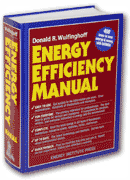Overview of…
4.9 Induction Systems
This part of the Energy Efficiency Manual shows you how to save energy in induction air handling systems. Induction systems are a form of single-duct reheat system, which is notoriously wasteful because it uses heating energy to warm up air that has been previously cooled. During low-load conditions, much more energy may be cancelled by reheat than actually enters the space to provide cooling or heating.
The primary air is cooled by a coil in the air handling unit. The temperature in individual spaces is regulated by a reheat coil in the terminal unit, which is controlled by the space thermostat.
The high pressure requirement increases fan power, even though the central fan delivers less volume. Also, induction systems are designed to operate with low primary air temperatures. This may require lower chilled water temperatures, which reduces the efficiency of the chiller.
The most visible distinguishing feature of an induction system is the terminal unit. Induction terminal units have no fans. Air movement through coils in the terminal unit is induced by high-pressure air, called “primary” air, that comes from a central air handling unit. The primary air is passed through an array of nozzles in the terminal unit that create a venturi effect, or vacuum. The vacuum recirculates air from the space through the terminal unit coil. The space air, called “secondary air,” mixes with the primary air and is discharged into the space.
Induction terminal units commonly are packaged in enclosures that are similar in size and appearance to fan-coil units. They may also be installed in ceiling plenums. The coils are almost always hydronic. The temperature of the coil may be controlled by throttling the water through the coil, or a damper may be installed in the terminal unit to bypass air around the coil.
If the terminal unit coils are designed to change between heating and cooling, the system will have much less reheat energy waste than if the coils are designed only for heating. When the space requires cooling, both the coil in the air handling unit and the coils in the terminal units cool the air. Reheat does not occur under these circumstances. However, when a space requires heating, the coil in the terminal unit must cancel the cooling energy in the primary air. The amount of reheating that is unavoidable depends on the diversity of the space loads. If some spaces have a high cooling load at the same time that other spaces have a heating load, reheating of the primary air will occur in the spaces that require heating.
Terminal units that have changeover coils require effective drainage of the moisture that condenses on the coils during cooling operation. The design of an induction system with changeover terminal unit coils may assume that dehumidification is accomplished by the coil in the air handling unit, rather than by the coil in the terminal unit. However, conditions can still occur that cause moisture to condense on the coils. The energy conservation measures presented here include the methods for avoiding excess reheat, which can be done with inexpensive temperature reset controls and other methods. You will learn to apply temperature setback to induction systems, along with techniques for maintaining air distribution efficiency.
Click here to return to the Table of Contents


